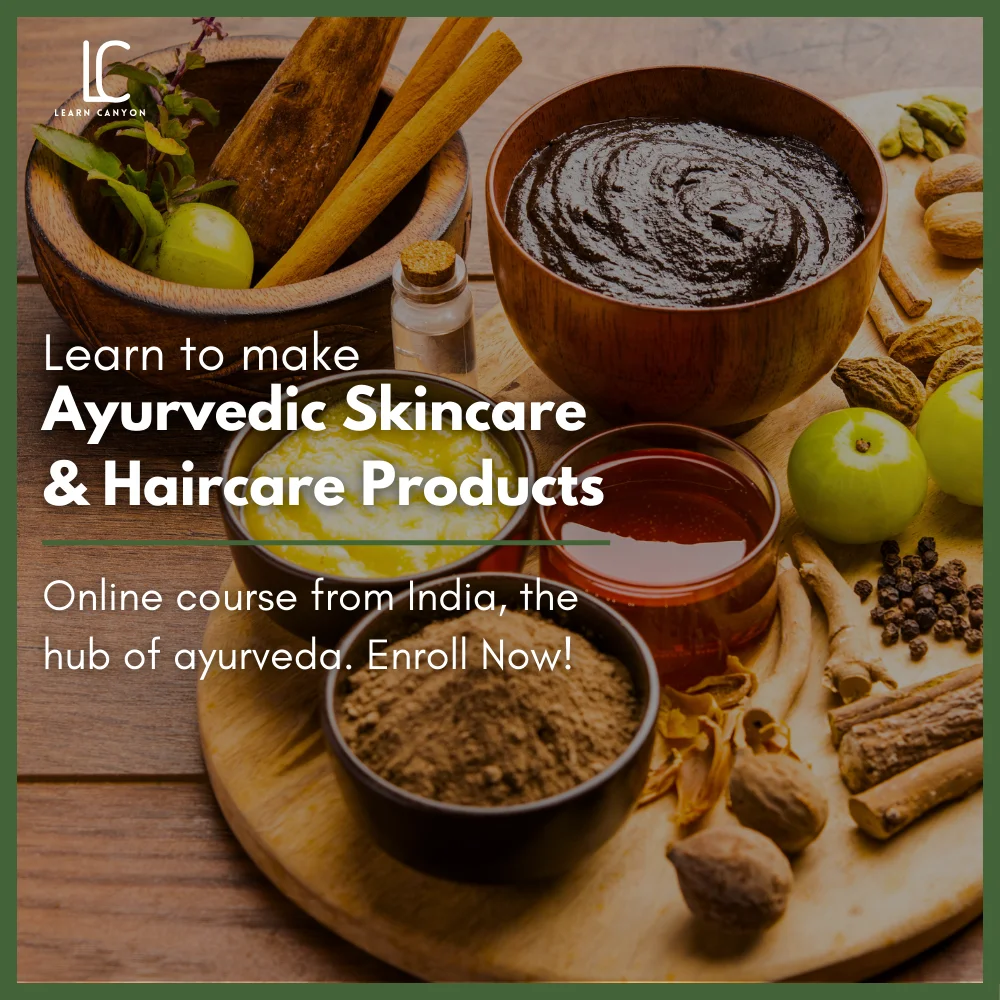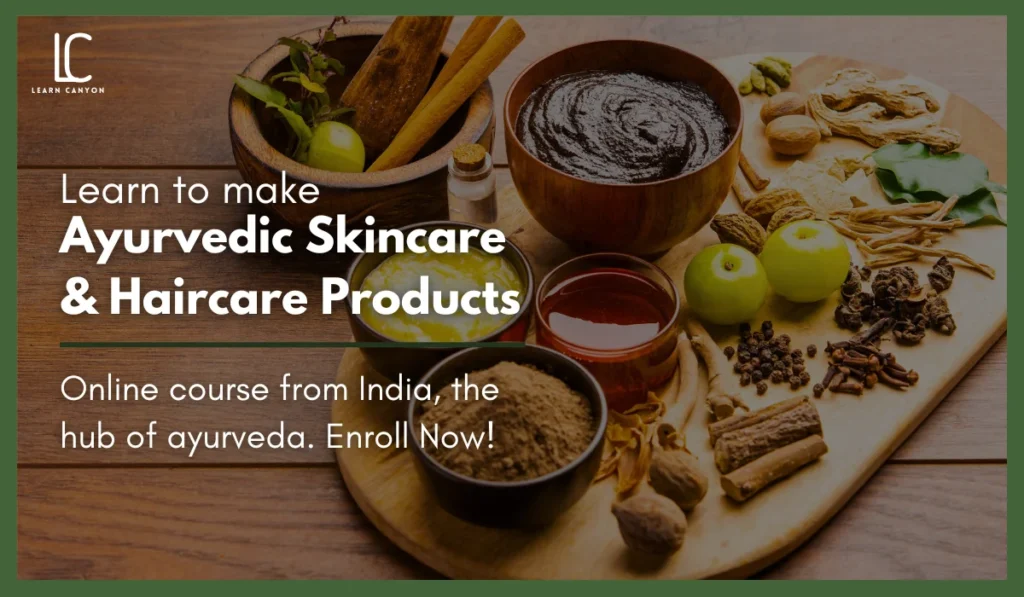$200 OFF ON EARLY BIRD | Use Coupon Code " AYURVEDA "
A course from India - a country renowned for its practice of Ayurveda
Create High-Quality Ayurvedic Skincare & Haircare Products
Presented by Learn Canyon Formulation School, Hosted by Auveda School of Learning
Outcome of the Course - Participants will gain comprehensive skills and knowledge to:
Create their own Ayurvedic cosmetic products.
Understand and apply the holistic principles of Ayurveda in product development
Navigate the regulatory landscape and successfully bring products to market.
Select and source high-quality, natural ingredients for formulations.
Customize products to address specific skin and hair concerns.
Implement sustainable and ethical practices in product development and packaging.
Brings together the wisdom of ancient practices and the science of modern cosmetic chemistry.
$200 OFF ON EARLY BIRD | Use Coupon Code " AYURVEDA "
We accept all major debit and credit cards and Paypal

Discover the Power of Ayurveda with Our 24-Month Comprehensive Programme
We’ll guide you step-by-step to become a confident ayurvedic formulator empowering you to create beauty products that people will love and demand.
A course From India, a Country known for Ayurveda
An Oldest culture of holistic healing
Comes an Formulations School: Learn Canyon
Here we believe in fuming the Natural ingredients and modern practices for crafting effective products
Products that can heal all the general and specific skincare and hair care problems
Products that promises to provide the radiant skin and healthy locks
And as a brand that has its roots in India,
Learn Canyon has worked around the core values of: Plant based, Natural balance and Sustainability
Dive Deeper into the World of Ayurveda and Cosmetic Chemistry - Transform Your Passion into Expertise
As a student here, you will learn:
All the necessary knowledge and skills to formulate your own ayurvedic skincare and hair care products from scratch.
To extract the power of nature, put it to best use and bottle it as your personal beauty solutions.
Learning the skill of formulations from Learn Canyon will empower you to:
Make your own ayurvedic and pure skincare and haircare products that are safe and effective on skin and hair
Share your knowledge and creativity with the world through products that create a positive impact of the lives of users
Imagine creating your own line of luxurious
Ayurvedic skincare and haircare products, each crafted with the wisdom of Ayurveda and the precision of modern cosmetic science.
Our Diploma in Ayurvedic Skincare and Haircare Formulation is designed to turn your passion into expertise, giving you the tools and knowledge to make a real impact in the beauty industry.
Does this sound like you?
You have a deep interest in Ayurvedic Skincare and Haircare Formulation,
BUT…
Are you holding yourself back from becoming an Ayurvedic Formulator???
Perhaps you feel overwhelmed about where to begin or unsure about which sources to trust, making it hard to take the first step.
Or maybe you’re questioning whether you’re investing in the right course.
You have a deep interest in Ayurvedic Skincare and Haircare Formulation,
BUT…
Are you holding yourself back from becoming an Ayurvedic Formulator???
Perhaps you feel overwhelmed about where to begin or unsure about which sources to trust, making it hard to take the first step.
Or maybe you’re questioning whether you’re investing in the right course.
Our Diploma in Ayurvedic Skincare and Haircare Formulation is designed just for you
Our course provides a comprehensive education in both the foundational principles of Ayurveda and modern cosmetic science. Designed by experienced cosmetic chemists and Ayurvedic practitioners, our curriculum covers everything from the history and development of Ayurveda to the detailed anatomy and physiology of skin and hair. You’ll gain the expertise needed to formulate high-quality products with confidence.
Our 24-month course is meticulously structured to guide you step-by-step through the learning process. With high-quality video content and detailed modules, we break down complex concepts into easy-to-understand lessons. Our expert-led mentorship ensures that you have reliable guidance and support every step of the way.
Our course includes personalized mentorship from industry experts with over 20 years of experience in Ayurvedic and cosmetic formulation. You’ll receive tailored feedback and advice, helping you navigate challenges and refine your skills effectively.
Our course emphasizes practical learning through interactive sessions and hands-on tutorials. You’ll have the opportunity to apply what you’ve learned by creating your own formulations, ensuring you’re well-prepared to develop your own line of Ayurvedic skincare and haircare products.
We provide comprehensive insights into the legal aspects of Ayurvedic product formulation, including how to apply for manufacturing licenses and adhere to Good Manufacturing Practices (GMP). You’ll learn the guidelines for product permissions and the regulatory landscape, ensuring your formulations are compliant and market-ready.
Our course integrates the ancient wisdom of Ayurveda with modern scientific techniques, teaching you to create products that are not only natural but also highly effective. You’ll learn to formulate customized solutions that cater to specific skin and hair types and conditions, leveraging the benefits of Ayurvedic ingredients and principles.
Brings together the wisdom of ancient practices and the science of modern cosmetic chemistry.
$200 OFF ON EARLY BIRD | Use Coupon Code " AYURVEDA "
We accept all major debit and credit cards and Paypal

Understanding Beauty in Ayurveda
In Ayurveda, beauty is the harmonious relationship between inner and outer selves. The more we nurture ourselves, the more radiant we become physically and expressively—regardless of body shape or proportions.
Ayurveda views beauty through three interconnected aspects: outer beauty, inner beauty, and the secret aspect. Balancing the outer and inner aspects leads to achieving the secret aspect. While outer beauty is a gift, inner beauty is an accomplishment.
Ayurveda has always understood beauty as a reflection of overall physical health and appropriate daily care, not merely a cosmetic event. The emphasis is on self-knowledge and the development of positive routines and habits that bring out the best in ourselves. Beauty, in Ayurveda, is not about fair complexion but the clarity and nourishment of tissue elements (dhatus), which vary from person to person.
Holistic Beauty Practices in Ayurveda
Ayurveda advises various daily and seasonal regimens, diets, massages, and other therapies to take care of the skin, hair, and other organs. Through our comprehensive course, you will learn to create a wide range of Ayurvedic formulations that promote holistic beauty and wellness.
By joining this course, you will be 60+ learning to formulate the following Ayurvedic products:
- Arka (Distillates)
- Kaatha (Decoctions)
- Taila (Medicated Oils)
- Avaleha or Leha (Herbal Jams)
- Paka (Confections)
- Kvatha (Herbal Decoctions)
- Churana (Herbal Powders)
- Dravaka (Liquid Formulations)
- Ksharas (Alkaline Preparations)
- Lepa (Herbal Pastes)
- Vatika and Gutika (Medicated Pills)
- Netra Bindu and Anjana Bindu (Eye Drops)
- Sattva (Herbal Extracts)
- Pisti (Mineral Preparations)
- Ghrita (Snehkalpa) (Medicated Ghee)
- Bhasma (Calcined Powders)
- Rasa Yoga (Herbo-Mineral Formulations)
- Kupipakwa Rasayana (Traditional Alchemical Preparations)
- Fant (Fanta) (Herbal Infusions)
- Nikadha (Concentrated Herbal Extracts)
- Ghana-Saar (Solid Extracts)
- Kalka (Herbal Pastes)
- Swarasa (Fresh Herbal Juices)
- Parpati Kalpas (Mercury-Based Preparations)
- Siddha-Milks (Medicated Milks)
- Kajjali (Black Sulphide of Mercury)
- Matras (Dosage Forms)
- Nassyas (Nasal Drops)
- Praash (Herbal Confections)
- Thailams (Herbal Oils for External Application)
- Kashayams (Herbal Decoctions for Internal Use)
- Choornams (Herbal Powders for Oral Use)
- Lehyams (Herbal Jams or Confections for Oral Use)
- Ghritams (Medicated Ghee for Internal Use)
- Asavas and Arishtas (Fermented Herbal Tonics)
- Ubtans (Herbal Cleansing Powders for Skin Care)
- Mukh Lepas (Face Packs)
- Nasyams (Nasal Drops for Detoxification)
- Kajal (Herbal Eye Liner)
- Herbal Teas (Infusions for Wellness)
- Herbal Bath Salts (For Skin Care and Relaxation)
- Herbal Shampoo (Natural Hair Cleanser)
- Herbal Conditioners (Hair Conditioners)
- Herbal Hair Oils (For Nourishment and Hair Growth)
- Herbal Hair Masks (For Hair Treatment)
- Herbal Mouthwash (Oral Hygiene Product)
- Herbal Toothpaste (Natural Dental Care)
- Herbal Face Serums (For Skin Rejuvenation)
- Herbal Sunscreens (Natural Sun Protection)
- Herbal Lip Balms (For Lip Care)
- Herbal Anti-Aging Creams (For Skin Care)
- Herbal Moisturizers (For Skin Hydration)
- Herbal Cleansers (For Skin Cleansing)
- Herbal Toners (For Skin Toning)
- Herbal Exfoliants (For Skin Exfoliation)
- Herbal Body Butters (For Deep Moisturization)
- Herbal Body Scrubs (For Skin Exfoliation)
- Herbal Bath Oils (For Skin Nourishment and Relaxation)
- Herbal Foot Care Products (For Foot Health and Relaxation)
- Herbal Cold and Flu Remedies (For Immunity Boosting) and more
Join us on a journey to master the art and science of Ayurveda. Whether you’re a beginner or a seasoned practitioner, our course is designed to provide you with valuable insights and practical knowledge. Start your holistic wellness journey today!
Exclusive Bonuses You Receive Upon Enrolling in Our Ayurveda Course
Extended Library Access: Access to a digital library of resources related to Ayurveda and cosmetic science, including e-books, articles, and research papers.
24*7 support: Personal mentorship from the industry experts
Lifetime Updates & Access : Free updates to course materials as new advancements in Ayurvedic skincare and haircare emerge.
Business Launch Kit: A comprehensive kit at the end of the course that includes a guide on starting and running a beauty business, templates for marketing materials, and initial legal consultation for business setup.
Portfolio Development Support : Assisting students in developing a professional portfolio that includes their formulations, research projects, and case studies from the course. This portfolio can be critical for job interviews and investor meetings.
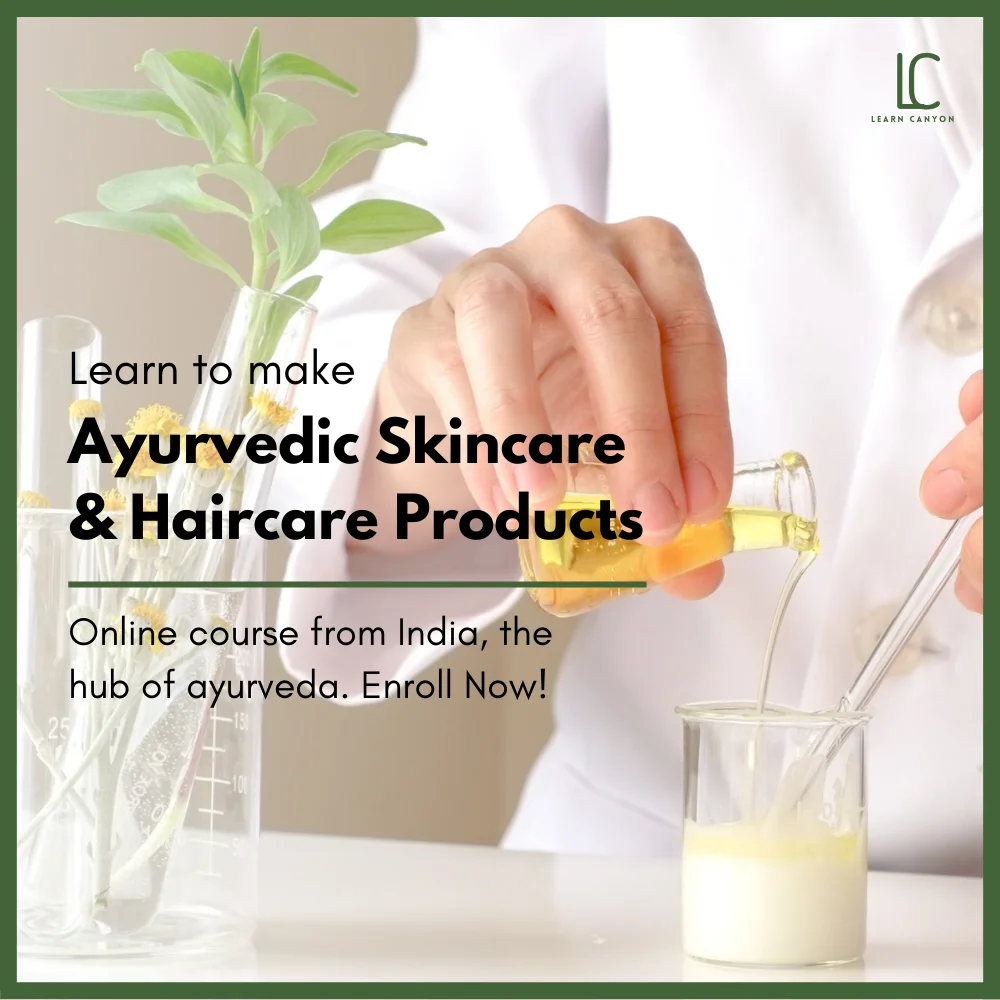
Brings together the wisdom of ancient practices and the science of modern cosmetic chemistry.
$200 OFF ON EARLY BIRD | Use Coupon Code " AYURVEDA "
We accept all major debit and credit cards and Paypal

course curriculum
Organic Skincare & Haircare Formulation
Module 1 - Everything about Ayurveda
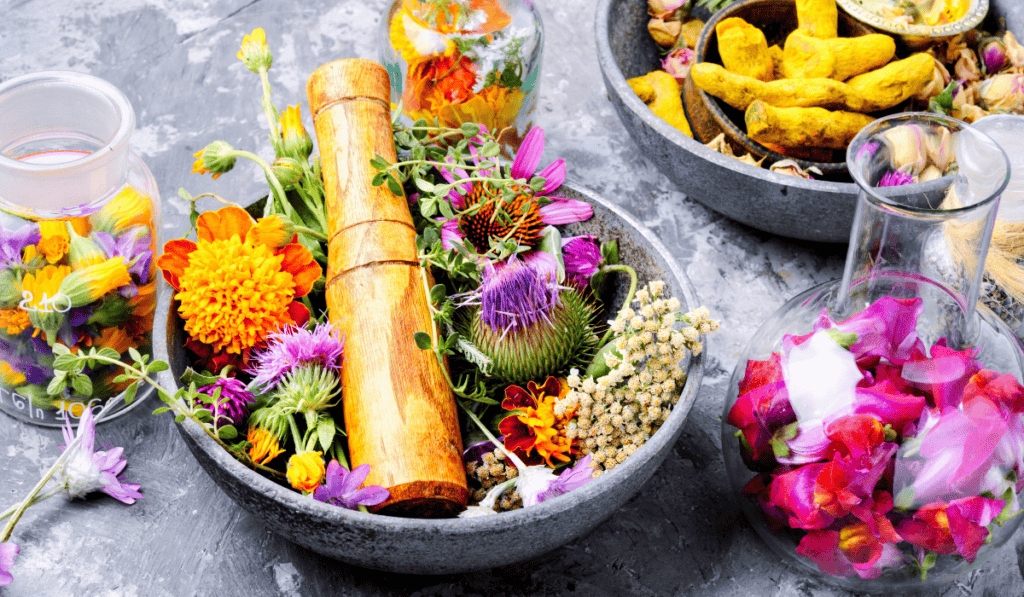
In this module, you will be introduced to the origin, history, and development of Ayurveda, the ancient science of Ayurvedic medicine. You will explore various ancient Ayurvedic scripts and understand how Ayurveda serves as a tool for holistic skin and hair care, focusing on concepts such as Tridoshas, Panchmahabhuta, and Sapta Dhatu. Additionally, you will learn about Oja, Malas, Strotas, and the relationship between Ayurveda and cosmetics.
1.1.1 The History of the Origin of Ayurveda
Explore the ancient roots and early development of Ayurveda.
1.1.2 Developmental Stages of Ayurveda
Understand how Ayurveda evolved over centuries.
1.1.3 Ayurveda – Indian System of Medicine
Learn about Ayurveda’s role as a traditional Indian medical system.
1.1.4 Recent History of Ayurveda
Study modern advancements and the global spread of Ayurveda.
1.1.5 Ayurveda as a Tool for Holistic Skin and Hair Care
Discover how Ayurvedic principles can be applied to skin and hair care.
1.2.1 Origin and Development of Ayurveda
Detailed exploration of the origins and growth of Ayurvedic practices.
1.2.2 Basic Principles of Ayurveda
1.2.2.1 Panchamahabhuta Theory
Learn about the five great elements and their significance.
1.2.2.2 Tridosha Theory
Understand the three doshas: Vata, Pitta, and Kapha.
1.2.2.3 Sapta-Dhatu (Seven Body Tissues) Theory
Study the seven body tissues and their functions.
1.2.3 Srotas or Channels
Learn about the bodily channels and their importance in health.
1.2.4 The Glow of Health – Oja
Discover the concept of Oja and its role in maintaining vitality.
1.2.5 The Dhatus, Upadhatus, and Malas
Understand the primary and secondary tissues and bodily waste.
1.2.6 Malas: Bodily Waste
Learn about the types and significance of bodily waste.
1.2.7 The Primary Cause of Disease
Study the fundamental causes of diseases according to Ayurveda.
1.2.8 Concept of Prakruti and Vikruti
Understand individual constitution (Prakruti) and imbalance (Vikruti).
Module 2 - Anatomy and Physiology of Skin and Hair
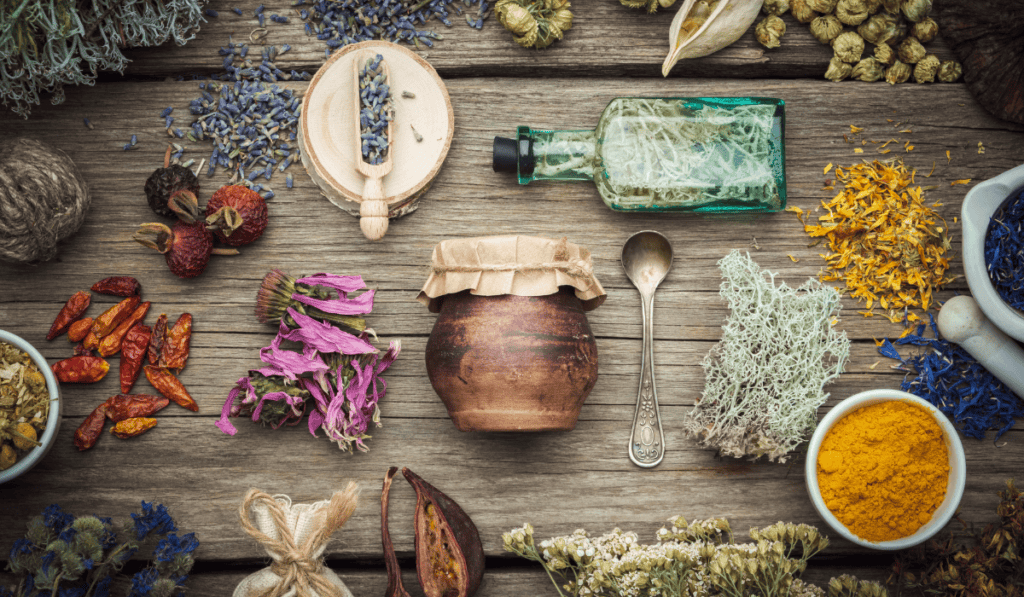
In this unit, we will focus on the skin as an organ, detailing its layers, formation, functions, and uses. You will learn to distinguish between skin types and textures according to Ayurvedic principles. This unit also covers the skin microbiome, the structure and functions of hair, and Ayurvedic classifications of hair types.
2.1.1 Introduction
Overview of the skin’s role and importance.
2.1.2 Structure of Skin
Detailed examination of skin layers.
2.1.3 Layers of Skin as Described in Ancient Ayurveda
Ayurvedic perspective on skin layers.
2.1.4 Functions of the Epidermis
Learn about the protective functions of the outer skin layer.
2.1.5 Functions of the Dermis
Study the supportive and structural roles of the dermis.
2.1.6 Functions of the Hypodermis
Understand the role of the subcutaneous layer.
2.1.7 Functions of Skin in Ayurveda
Ayurvedic interpretation of skin functions.
2.1.8 Common Types of Skin
Learn about the various skin types.
2.1.9 Ayurvedic Skin Types
Study skin types according to Ayurvedic doshas.
2.1.10 Skin Colour
Explore the factors that determine skin colour.
2.1.11 Factors Responsible for Skin Colour
Detailed look at pigmentation and other influencing factors.
2.1.12 Mechanisms of Skin
Understand how skin maintains its health and function.
2.1.13 Mechanism of Keratinization
Learn about the process of skin cell regeneration.
2.1.14 Skin Microbiome and Associated Terms
Study the beneficial and harmful bacteria on the skin.
2.2.1 Introduction
Overview of hair’s role and importance.
2.2.2 Generation of Hair
Learn about the hair growth cycle.
2.2.3 Hair Structure
Detailed examination of hair anatomy.
2.2.4 Ayurvedic Hair Types
Study hair types according to Ayurvedic doshas.
2.2.5 Functions of Hair
Understand the various roles hair plays in health and protection.
Module 3 - Holistic Internal Health and Its Effects
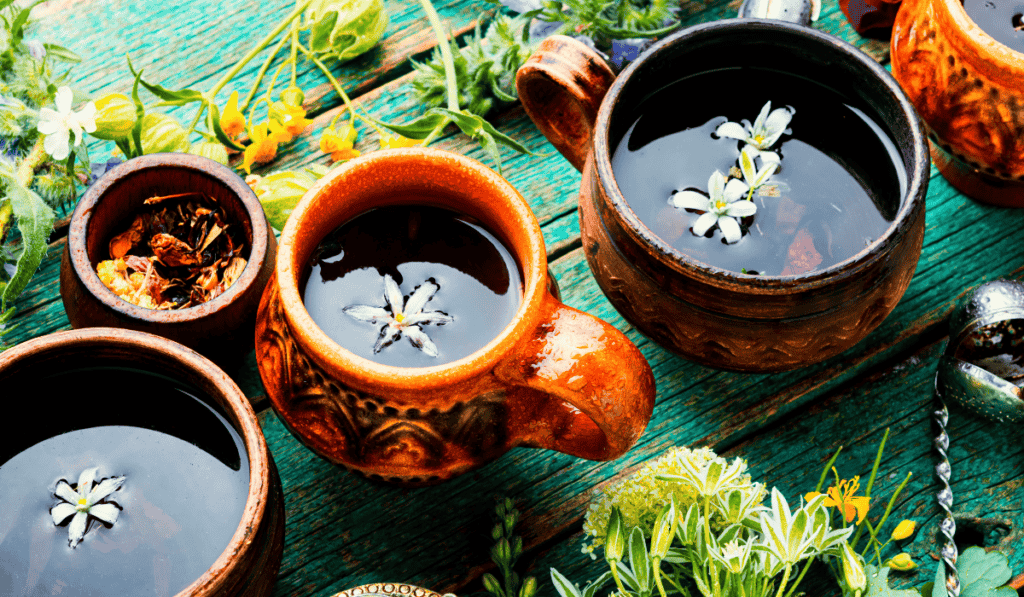
This unit explores the internal processes of the body and their effects on the external appearance and health of skin and hair. You will understand the digestive, absorption, and excretion systems, and their impact on skin health. The unit also covers various helpful herbs and their uses.
3.1.1 Introduction
Overview of the connection between internal health and external appearance.
3.1.2 Relation Between Skin Health and Rasa Dhatu (Plasma and Other Fluids)
Understand the role of plasma and other fluids in skin health.
3.1.3 Relation Between Skin Health and Rakta Dhatu (Blood)
Study the importance of blood in maintaining healthy skin.
3.1.4 Relation Between Skin Health and Mamsa (Muscle)
Learn about the connection between muscle health and skin.
3.1.5 Relation Between Skin Health and Ojas (Immunity)
Discover how immunity affects skin health.
3.1.6 Relation Between Digestion and Health
Explore the impact of digestive health on overall wellness.
3.1.7 Skin Health and Herbs Effective Against Tridosha
Learn about herbs that balance the three doshas and promote skin health.
3.1.8 Skin Health with Topical Applications
Study the benefits of applying herbs and other natural ingredients to the skin.
3.2.1 Introduction
Overview of the importance of herbs in Ayurveda.
3.2.2 Turmeric
3.2.3 Basil
3.2.4 Neem
3.2.5 Rakta Chandan
3.2.6 Sesame
3.2.7 Herbs Beneficial for Hair
Study specific herbs and their effects on hair health.
3.2.8 Hibiscus rosa-sinensis Linn (Malvaceae)
3.2.9 Cuscuta reflexa Roxb (Convolvulaceae)
3.2.10 Ocimum gratissum Linn (Lamiaceae)
3.2.11 Ginseng radix (Araliaceae)
3.2.12 Aloe vera L. (Liliaceae)
3.2.13 Rosmarinus officinalis Linn (Labiatae)
3.2.14 Lawsonia alba L. (Lythraceae)
3.2.15 Ginkgo biloba (Ginkgoaceae)
3.2.16 Tridax procumbens L. (Compositae)
3.2.17 Sophora flavescens (Leguminous plants)
3.2.18 Citrullus colocynthis Schrad (Cucurbitaceae)
3.2.19 Emblica officinalis (Euphorbiaceae)
3.2.20 Trigonella foenumgraecum (Leguminosae)
3.2.21 Murraya koenigii (Rutaceae)
3.2.22 Nordostachys jatamansi (Valerianaceae)
3.3.1 Introduction
Overview of how internal health affects the skin.
3.3.2 Digestive Health and Skin
3.3.2.1 The Gut-Skin Connection
3.3.2.1.1 Healthy Gut Function
3.3.2.1.2 Herbs That Benefit the Skin by Supporting the Gut
3.3.2.1.2(a) Astringents
3.3.2.1.2(b) Vulneraries and Anti-Inflammatories
3.3.2.1.2(c) Bitters and Digestive Wellness
3.3.2.2 Hepatic Health and the Skin
3.3.2.2.1 Biotransformation & Detoxification of Skin
3.3.2.2.2 Dietary Supplements to Promote Health
3.3.2.2.3 Choosing Hepatic Herbs to Help Your Skin
3.3.2.2.3(a) Ganoderma lucidum (Ganodermataceae) – Mushroom
3.3.2.2.3(b) Ginger, Zingiber officinale
3.3.2.2.3(c) Cardamom, Elettaria cardamomum
3.3.2.2.4 Ten Good & Bad Foods for Your Liver
3.3.2.3 Excretory Health and the Skin
3.3.2.3(a) Castor Oil, Ricinus communis
3.3.2.3(b) Guava, Psidium guajava
3.3.2.3(c) Grapes, Vitis vinifera
**3.3.2.3(d) Bananas, Musa acuminata, Musaacuminata, Musa balbisiana, and Musa paradisiaca**
3.3.1 Introduction
Overview of how internal health affects the skin.
3.3.2 Digestive Health and Skin
3.3.2.1 The Gut-Skin Connection
3.3.2.1.1 Healthy Gut Function
3.3.2.1.2 Herbs That Benefit the Skin by Supporting the Gut
3.3.2.1.2(a) Astringents
3.3.2.1.2(b) Vulneraries and Anti-Inflammatories
3.3.2.1.2(c) Bitters and Digestive Wellness
3.3.2.2 Hepatic Health and the Skin
3.3.2.2.1 Biotransformation & Detoxification of Skin
3.3.2.2.2 Dietary Supplements to Promote Health
3.3.2.2.3 Choosing Hepatic Herbs to Help Your Skin
3.3.2.2.3(a) Ganoderma lucidum (Ganodermataceae) – Mushroom
3.3.2.2.3(b) Ginger, Zingiber officinale
3.3.2.2.3(c) Cardamom, Elettaria cardamomum
3.3.2.2.4 Ten Good & Bad Foods for Your Liver
3.3.2.3 Excretory Health and the Skin
3.3.2.3(a) Castor Oil, Ricinus communis
3.3.2.3(b) Guava, Psidium guajava
3.3.2.3(c) Grapes, Vitis vinifera
**3.3.2.3(d) Bananas, Musa acuminata, Musaacuminata, Musa balbisiana, and Musa paradisiaca**
3.4.1 Introduction
Overview of the role of nutrition in skin health.
3.4.2 Balanced & Healthy Diet for Glowing Skin
Learn the components of a diet that promotes skin health.
3.4.3 What is a Balanced Diet?
3.4.3.1 Nutritional Ingredients for Skin
Study the essential nutrients needed for healthy skin.
3.5.1 Introduction
Overview of Ayurvedic lifestyle practices for health and wellness.
3.5.2 Concept of Healthy Living in Ayurveda
Learn the principles of a balanced and healthy life according to Ayurveda.
3.5.3 Personal and Social Hygiene
Understand the importance of hygiene in maintaining health.
Module 4 - Addressing Skin and Hair Issues
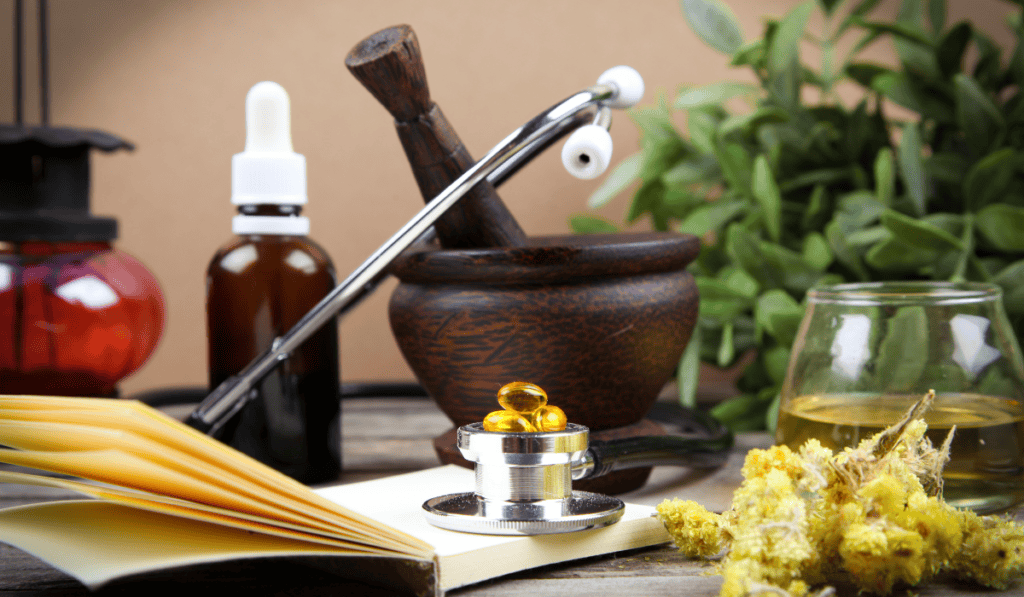
This unit covers various skin and hair problems, their causes, factors affecting them, and methods of control. You will learn about common issues such as acne, sunburns, wrinkles, hair loss, and dandruff, and the importance of TEWL, collagen, and sebum.
4.1.1 Skin Conditions
Learn about various skin conditions and their causes.
4.1.2 Transepidermal Water Loss (TEWL)
Understand the concept of TEWL and its impact on skin health.
4.1.3 Adverse Skin Conditions
Study the factors that lead to adverse skin conditions.
4.1.4 Collagen
Learn about the role of collagen in skin health.
4.1.5 Classification of Wrinkles
4.1.5.1 Free Radicals as a Cause of Aging
4.1.5.2 Reactive Oxygen Species and Their Antioxidants
4.1.6 Photoaging
Understand the effects of UV exposure on skin aging.
4.1.7 Antioxidants
Learn about the role of antioxidants in protecting the skin.
4.2.1 Damaged Hair
Study the causes and treatments for damaged hair.
4.2.2 Greying
Learn about the factors that contribute to hair greying.
4.2.3 Hair Loss
Understand the causes and solutions for hair loss.
4.2.4 Greasy Scalp
Study the reasons for and treatments of a greasy scalp.
4.2.5 Dandruff
Learn about the causes and treatments for dandruff.
4.2.6 Split Ends
Understand what causes split ends and how to prevent them.
4.2.7 Dry Hair
Study the factors that lead to dry hair and how to address them.
4.2.8 Ayurvedic Approach to Hair Problems
Learn about Ayurvedic methods for addressing various hair problems.
Module 5 - Ayurvedic Ingredient Studies
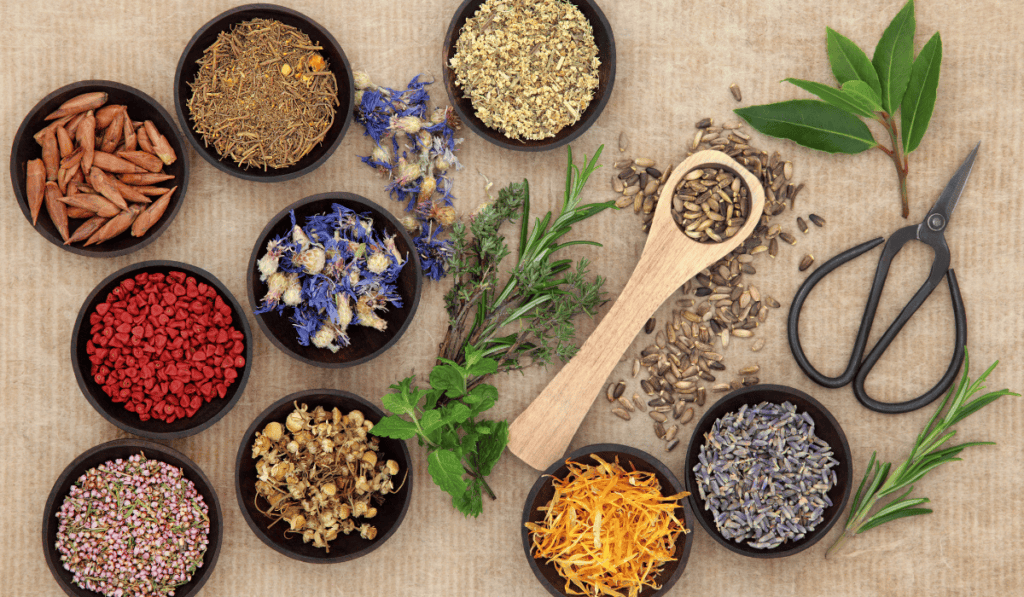
This unit provides an in-depth understanding of various types of ingredients used in Ayurvedic formulations. You will learn about oils, fats, waxes, antibacterials, antioxidants, and other ingredient types, their mechanisms of action, and uses.
5.1.1 Introduction
Overview of the importance of ingredients in Ayurvedic formulations.
5.1.2 Oils & Fats
Study the different oils and fats used in Ayurveda and their benefits.
5.1.3 Waxes
Learn about various waxes and their uses in formulations.
5.1.4 Surface Active Agents / Emulsifiers
Understand the role of emulsifiers in product formulations.
5.1.5 Cleansers
Study different types of cleansers and their properties.
5.1.6 Exfoliants
Learn about the various exfoliants used in Ayurvedic products.
5.1.7 Humectants
Understand the role of humectants in skin hydration.
5.1.8 Hydrosols
Study the uses and benefits of hydrosols.
5.1.9 Higher Fatty Acids
Learn about the importance of higher fatty acids in skin care.
5.1.10 Higher Alcohols
Study the role of higher alcohols in formulations.
5.1.11 Esters
Learn about esters and their uses in cosmetics.
5.1.12 Thickening Agents
Study various thickening agents used in Ayurvedic products.
5.1.13 Natural Polymers
Understand the role of natural polymers in formulations.
5.1.14 Vitamins
Learn about the importance of vitamins in skin care.
5.1.15 Skin Whitening Agents / Anti-Pigmentation
Study ingredients that help with skin whitening and pigmentation issues.
5.1.16 Antibacterial Agents
Learn about various antibacterial agents used in Ayurvedic formulations.
5.1.17 Anti-Inflammatory and Pain Relievers
Study the ingredients that provide anti-inflammatory and pain relief benefits.
5.1.18 Astringents
Learn about astringents and their uses in skin care.
5.1.19 Anti-Acne / Anti-Pimple
Study ingredients effective in treating acne and pimples.
5.1.20 Fresheners or Refrigerants
Learn about ingredients that refresh and cool the skin.
5.1.21 Anti-Cellulite
Study the ingredients used to treat cellulite.
5.1.22 Sunscreens
Learn about natural sunscreens and their benefits.
5.1.23 Antioxidants
Understand the role of antioxidants in protecting the skin.
5.1.24 Anti-Dandruff
Study ingredients effective in treating dandruff.
5.1.25 Preservatives
Learn about natural preservatives used in Ayurvedic products.
5.1.26 Perfumes
Study the role of natural perfumes in formulations.
5.1.27 Pigments
Learn about natural pigments used in cosmetics.
Detailed study of individual ingredients, their chemical compositions, sources, and uses.
Module 6: Understanding Ayurvedic Formulations
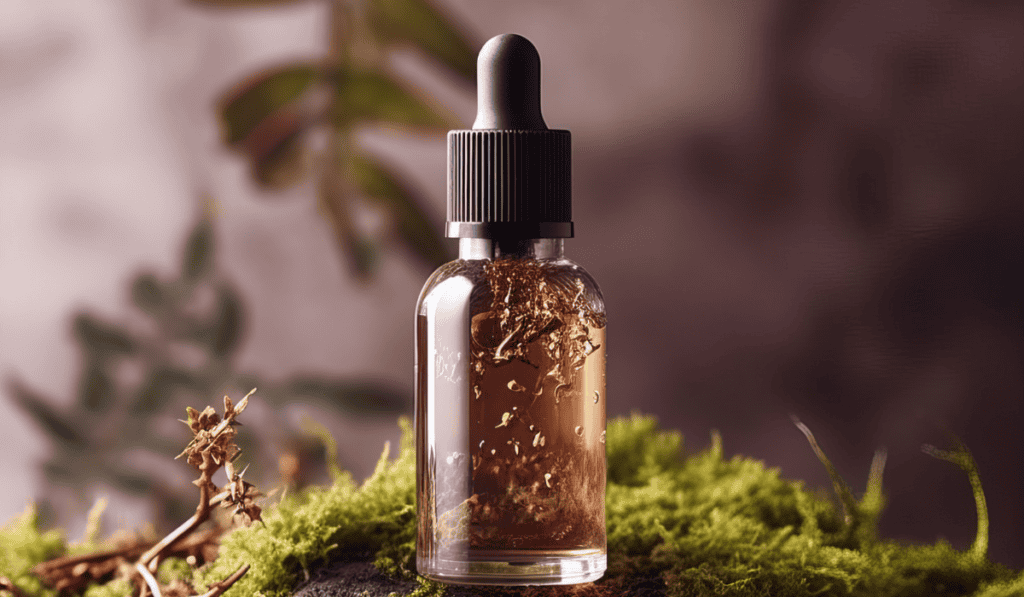
This unit introduces various types of Ayurvedic formulations as described in ancient scriptures. You will learn the traditional preparation methods of Arka, Kaatha, Taila, and more, along with examples of classic Ayurvedic formulations.
6.1.1 Introduction
Overview of Ayurvedic formulations and their significance.
6.1.2 Asava and Arishta
Learn about these traditional Ayurvedic preparations.
6.1.3 Arka
Study the preparation and uses of Arka.
6.1.4 Avaleha or Leha and Paka
Understand these herbal formulations and their benefits.
6.1.5 Kvatha (Decoction)
Learn about the preparation and uses of herbal decoctions.
6.1.6 Churana
Study powdered formulations and their applications.
6.1.7 Dravaka
Understand the preparation and benefits of liquid formulations.
6.1.8 Ksharas
Learn about alkaline preparations in Ayurveda.
6.1.9 Lepa
Study herbal pastes and their uses.
6.1.10 Vatika and Gutika
Learn about medicated pills and their benefits.
6.1.11 Netra Bindu and Anjana Bindu
Study Ayurvedic eye treatments.
6.1.12 Sattva
Learn about the preparation and uses of Sattva.
6.1.13 Pisti
Study mineral-based formulations.
6.1.14 Ghrita (Snehkalpa)
Learn about medicated ghee and its uses.
6.1.15 Taila (Medicated Oils)
Study the preparation and benefits of medicated oils.
6.1.16 Bhasma
Understand the preparation and uses of calcined powders.
6.1.17 Rasa Yoga
Learn about herbo-mineral formulations.
6.1.18 Kupipakwa Rasayana
Study traditional alchemical preparations.
6.1.19 Fant (Fanta)
Learn about the preparation and uses of herbal infusions.
6.1.20 Nikadha
Understand the preparation and benefits of Nikadha.
6.1.21 Ghana-Saar
Learn about concentrated herbal extracts.
6.1.22 Kalka
Study herbal pastes and their uses.
6.1.23 Swarasa
Learn about fresh herbal juices and their benefits.
6.1.24 Parpati Kalpas
Study traditional mercury-based preparations.
6.1.25 Siddha-Milks
Learn about medicated milks and their uses.
6.1.26 Kajjali
Study the preparation and uses of Kajjali.
6.1.27 Matras
Learn about Ayurvedic dosage forms.
6.1.28 Nassyas
Study nasal drops and their benefits.
6.1.29 Praash
Learn about herbal jams and their uses.
Detailed study of individual ingredients, their chemical compositions, sources, and uses.
Module 7: Daily Routines and Remedial Practices
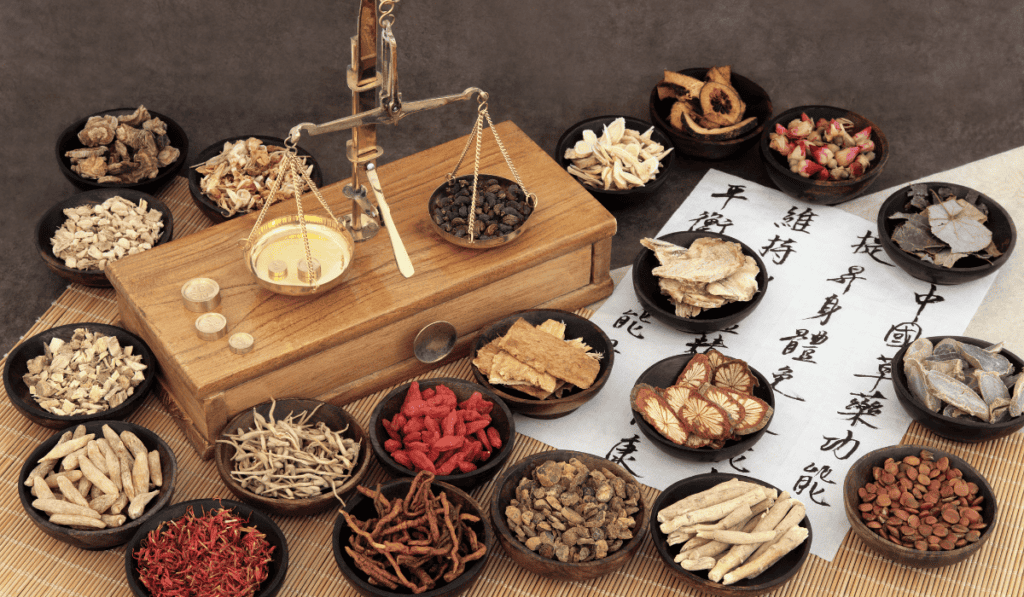
This unit discusses the importance of routines in skin and hair health maintenance, emphasizing the right approach to care and the role of diet.
7.1.1 Introduction
Overview of Ayurvedic skin care routines.
7.1.2 Cleansing Routines
Learn about Ayurvedic cleansing practices.
7.1.3 Steps in Skin Care
Study the steps involved in Ayurvedic skin care.
7.1.4 Ayurveda and Skin Care
Understand how Ayurveda approaches skin care.
7.2.1 Ayurveda’s Approach to Hair Care
Learn about Ayurvedic hair care practices.
7.2.2 Benefits of Topical Hair Treatments
Study the benefits of applying herbal treatments to the hair.
7.2.3 Herbs That Support Hair Health
Learn about herbs that promote healthy hair.
7.2.4 Scalp Care
Understand the importance of scalp health.
7.2.5 Diet for Healthy Hair
Study the role of diet in maintaining healthy hair.
Module 8: Regulatory and Manufacturing Insights
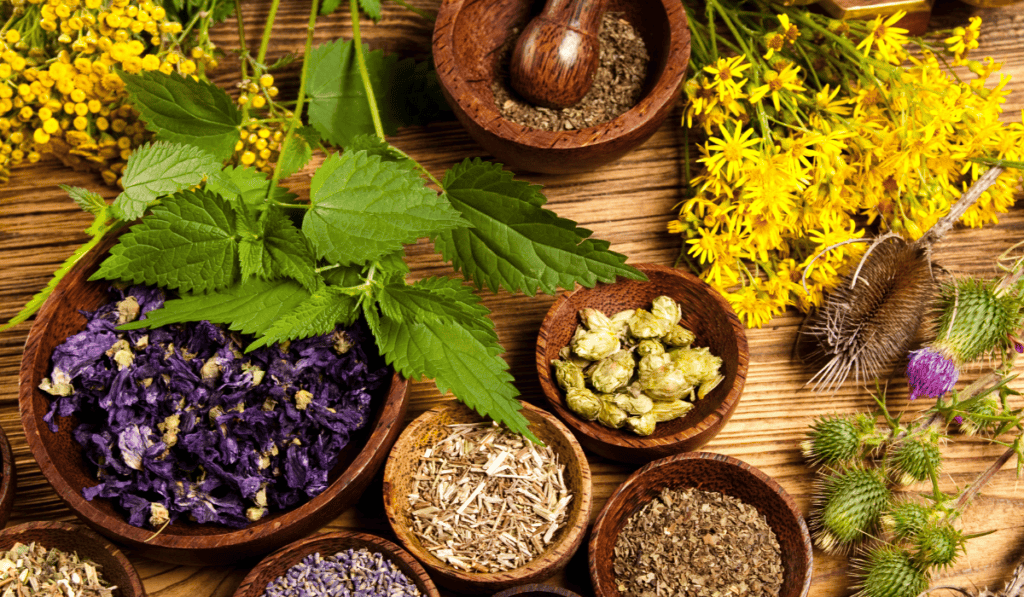
This unit covers the legal aspects and good manufacturing practices necessary for Ayurvedic product formulation. You will learn about various licenses required and the application process.
8.1.1 Introduction
Overview of the legal aspects of Ayurvedic drug manufacturing.
8.1.2 How to Apply for a License to Manufacture Ayurvedic Drugs
Learn about the process of obtaining a manufacturing license.
8.1.3 Good Manufacturing Practice (GMP)
Study the principles of good manufacturing practices.
8.1.4 Product Permission Guidelines (License with Regard to Products)
Understand the guidelines for product permissions and licensing.
Detailed study of individual ingredients, their chemical compositions, sources, and uses.
Brings together the wisdom of ancient practices and the science of modern cosmetic chemistry.
$200 OFF ON EARLY BIRD | Use Coupon Code " AYURVEDA "
We accept all major debit and credit cards and Paypal

Key Highlights of Our Ayurveda Course
Expert Instruction: Learn from leading experts who have decades of experience in both the traditional art of Ayurveda and the precision of modern cosmetic science.
Comprehensive Curriculum: Explore every aspect of Ayurvedic and cosmetic formulation—from the foundational principles to advanced techniques.
Interactive Learning Environment: Engage with content through immersive videos, live webinars, and interactive Q&A sessions.
Tailored Mentorship: Receive personalized feedback and guidance from professionals to refine your skills and ensure your formulations meet industry standards.
Who Should Enroll: Discover if This Program is Right for You
- Individuals looking to enter or transition to natural beauty product formulation.
- Professionals in the beauty industry seek to enhance their knowledge and skills with Ayurvedic practices.
- Entrepreneurs wanting to launch or expand their own line of natural skincare and haircare products.
- People looking for Proficiency in Formulation. Ability to independently create safe, effective, and innovative Ayurvedic skincare and haircare products.
Learn the Art of Ayurvedic Skincare and Haircare Formulation
- Fundamentals of Ayurveda: Understanding the principles like Tridoshas, Panchmahabhuta, and more.
- Anatomy and Physiology: In-depth knowledge of skin and hair structure from an Ayurvedic perspective.
- Holistic Internal Health: Effects of the body’s internal processes on skin and hair health.
- Formulation Techniques: Hands-on experience in making various Ayurvedic skincare and haircare products.
- Understanding Ayurvedic Formulations: Traditional methods and modern adaptations in Ayurvedic recipes.
- Ingredient Knowledge: Deep dive into natural ingredients used in traditional Ayurvedic recipes. Detailed study of oils, herbs, and other natural components used in formulations.
- Product Development: Insights into manufacturing, legal aspects, and market entry for Ayurvedic cosmetic products.
- Regulatory and Manufacturing Insights: Overview of the legal framework and manufacturing practices.
- Overall Skills to start or enhance your own business in the beauty industry, with a focus on natural and holistic products.
Brings together the wisdom of ancient practices and the science of modern cosmetic chemistry.
$200 OFF ON EARLY BIRD | Use Coupon Code " AYURVEDA "
This course bridges the gap between ancient Ayurvedic practices and modern cosmetic science, providing a comprehensive education that is designed to empower aspiring formulators with the knowledge and skills needed to create high-quality, natural beauty products.

